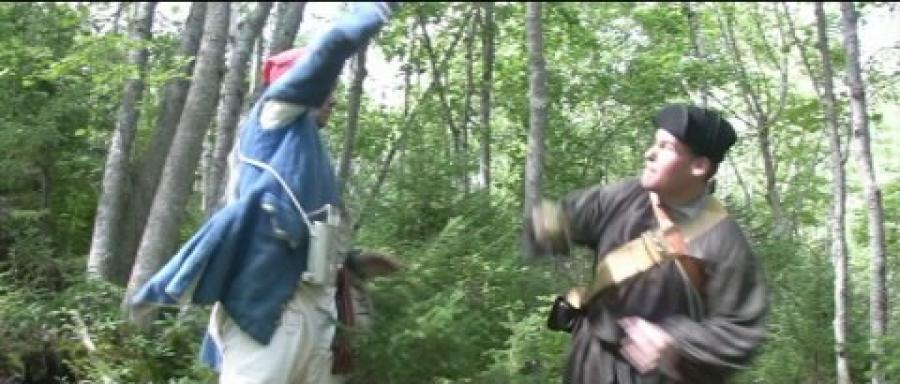Interlude: A Word About Action Scenes
Some folks think A Tale of Bloody Creek was inspired by Michael Mann’s 1992 version of Last of the Mohicans, but as I’ve already explained, Northwest Passage was the direct influence, so much so that I came up with my story while watching that film, in particular the scenes in which Rogers’ Rangers tramp through the wilderness and are pursued by their enemies. Another major influence was Werner Herzog’s Aguirre: the Wrath of God, which also features a band of soldiers stumbling through a wilderness setting. Some of my long, dreamy shots come from that one. It’s a tough movie, but also a great movie.
The third influence is the 1958 Kirk Douglas epic The Vikings, a film I first saw when I was about twelve or thirteen. The climactic duel in Bloody Creek owes a lot to the sword fight at the end of The Vikings. I’d always wanted to stage a fight on a rocky headland above rolling waves, and now I have.
It would be untrue, however, to say that Mohicans was not an influence at all. It’s the standard for movies set during the French and Indian War, despite the fact that it’s filled with troubling inaccuracies about what that war was all about (no time to go into that here, though!) Re-enactors love it, and I’m a fan too, mainly for its look and feel and for the incredible action scenes. And this is where the greatest influence comes from: the action. In the lead-up to filming Bloody Creek, I studied some of those scenes, watching them over and over to see how they were done. And I discovered something interesting: good action scenes are all about the editing.

By this I don’t mean that it’s as simple as making a lot of quick cuts to generate excitement. I’m not impressed with movie action that’s so quick you can’t follow it. The true secret to editing in action scenes is the creation of the illusion of brutal violence.
Here’s how it works. Say your scene involves two men, Fighter A and Fighter B. They’re locked in combat, each armed with a hatchet. You don’t really want one of your actors to get hit with a hatchet, but you don’t want your scene to look phony. You don’t want the actors to look like they’re pulling their punches. So you film Fighter A, who will win the fight, as he swings his hatchet through the air, with Fighter B nowhere nearby; zoom in nice and tight. Then you shoot a second clip from a different angle, as if you’re seeing the same event from a different spot. As you prepare for this clip, you have Fighter A rest his weapon against Fighter B’s head – just rest it. When you cry, “Action,” Fighter A follows through as if he’s just hit Fighter B. Fighter B reacts and falls down. You then cut the two clips together, adding sound effects – very important – at the supposed moment that the hatchet impacts B’s head. The sound of the weapon striking home fools the brain to some degree, while the quick edits add some visual energy.
I should also mention that your actors have to really get into it. Fighter A has to swing that hatchet for all he’s worth, like he’s really trying to split open a pumpkin, or it will look lame and fake. Fighter B has to fall like he’s not afraid to get hurt.
This was how I shot most of the fight scenes in Bloody Creek, and many people have said that they’re very effective. I’ve seen them a thousand times now and cringe at the little things that I now think didn’t work so well, but the good parts make me happy. A few of the best hits still make me chuckle.
